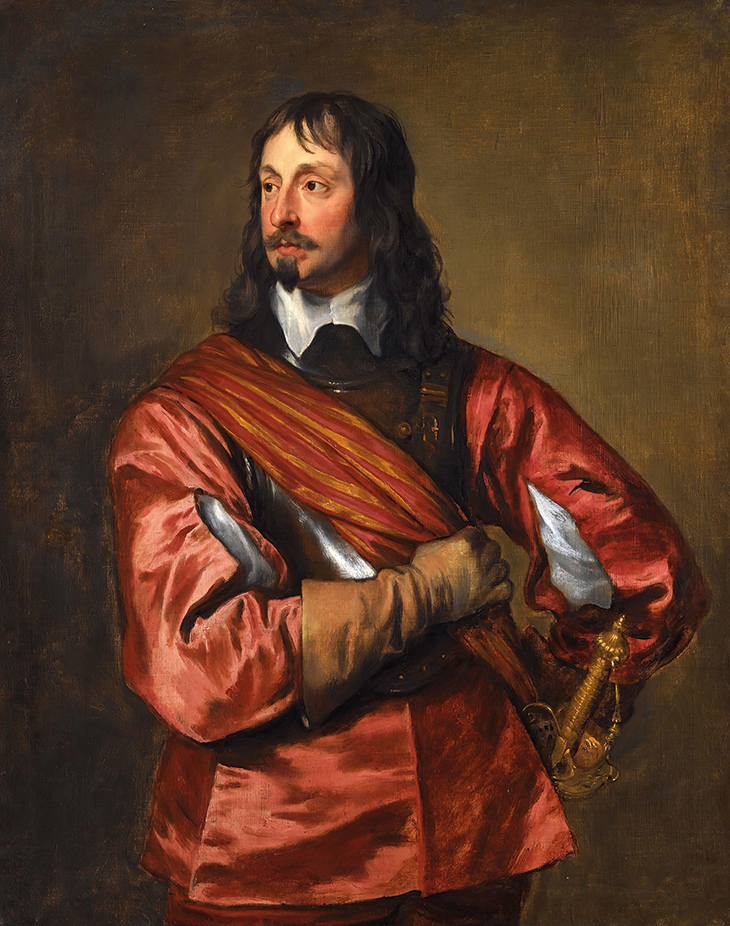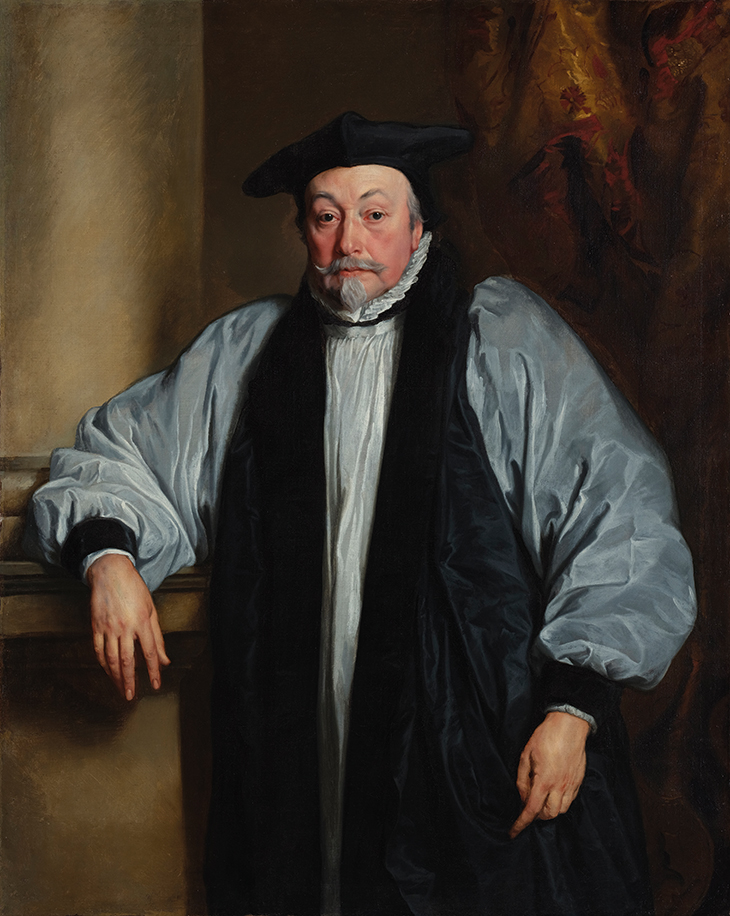Sir Edward Hyde, later 1st Earl of Clarendon, veteran statesman and voluminous historian of the reign of Charles I, wrote of that monarch’s rule without Parliament from 1628–40 as a time when ‘this kingdom […] enjoyed the greatest calm and the fullest measure of felicity that any people in any age for so long time together have been blessed with’. One of Clarendon’s modern biographers, Richard Ollard, more pithily called his subject’s depiction of Caroline England before the civil wars ‘as sound as a biscuit’. Since I began writing a partial life of Hyde in his earlier years, it has struck me that he was tellingly indifferent to one positive aspect of these years which historians of every political persuasion today generally accept: the delicate aesthetic glory of Caroline painting and portraiture, associated above all with the career of Anthony van Dyck.
Tom Carew, Hyde’s most raffish youthful friend, a brilliant, scapegrace courtier poet, in one verse epistle outdoes even Ollard’s biscuit, summing up the years of the king’s personal rule as ‘our Halcyon dayes’. ‘Halcyon’ refers to the kingfisher, that bird of bright hue and royal association, to whose nest-building Carew returns later in the poem. Carew consistently celebrates a supremely aesthetic court. His greatest love elegy, ‘A Rapture’, is in every sense explicitly Titianesque. The Van Dyck portrait once assumed to depict Carew was likely misattributed, but that the poet lived in and wrote from the very milieu that Van Dyck painted is incontestable.
The dates of Anthony van Dyck’s personal ascendancy over Caroline court portraiture possess irresistible historical significance. He was fetched to London for good in 1632, at the height of Charles’s apparently tranquil rule without Parliament. He died, so much in harness that, despite the able assistance of a well-oiled workshop, he is generally thought to have perished of overwork, at the close of 1641, all but expiring along with peace in England.
Before Van Dyck’s arrival the court’s leading portraitist was the more Anglicised Daniel Mytens. His works have a certain retro appeal, incarnating as they do a mode on the brink of oblivion. To look at Mytens’s Charles I or his image of the king’s future battlefield opponent, the 3rd Earl of Essex, is to behold dreaming Duke Orsino and the would-be Count Malvolio in their gaudy wooing best. Mytens’s endearingly stiff staginess was to be supplanted by Van Dyck with a vivacity that passes straight from the interiority of their subjects into the susceptibility of their viewers.
During his brief first visit to London in 1621, the 22-year-old Van Dyck had been much taken with the Titians collected by the Earl of Arundel, the first he had ever seen. The Venetian and Dutch masters innately shared startling psychological access to their sitters, though they did not always care to show it.

Sir John Mennes (c. 1637–38), Anthony van Dyck. Photo: Artefact/Alamy Stock Photo
Van Dyck’s Sir John Mennes, by its splendid masquing costume the product of the high, roaring royal 1630s, reveals this easy-going naval functionary, the love-poet Robert Herrick’s drinking partner, later to be the despair of his own conscientious underling Samuel Pepys, quite as clearly, affectionately and roguishly as Titian’s portraits of Pietro Aretino or Jacobo Strada.
But Sir Anthony had learnt the courtier’s gift for concealing, as well as disclosing, character. His ravishing fairy vision of Charles’s consort Henrietta Maria was painted about 1636, the last year in which the court could consider the condition of the British kingdoms with more or less undiluted satisfaction. Neither the queen’s decided personality nor her diminutive stature is permitted to unsettle an archetype largely inherited from Elizabeth I, the long-dead ‘Gloriana’ herself.
Van Dyck soon became sufficiently indispensable to paint, if he chose, candidly to the point of mischievousness. His timorous Archbishop Laud, already close to his fall from eminence in 1641, appears, Angus Haldane suggests, awkwardly conscious of his own complaints to the king about Van Dyck’s costliness. The Parliamentarian oligarchy at its worst was pinioned before it was formed in Van Dyck’s 1639 portrait of the severely Puritan, enormously rich, vainly plain MP Arthur Goodwin, all hard stares and expensively varied browns, down to his tangibly top-of-the-range cavalry boots.

Archbishop Laud (c. 1635), Anthony van Dyck. Photo: © Fitzwilliam Museum, Cambridge
Ruskin, in identifying the ‘insecurity’ of Van Dyck’s subjects as their besetting constant, was surely only half right. Especially when considering the military ‘swagger’ double portraits of the increasingly storm-clouded late 1630s – the comrades-in-arms Lords Goring and Newport, the brothers-in-law Lords Digby and Bedford, the Aubigny Stuart brethren and royal cousinry Lords John and Bernard – the over-informed viewer is inclined to stamp over what they see as a hindsighted chronicle of hubris, estrangement, futile defeat and death. In fact it is too whimsical, when in the presence of these certainly poignant masterpieces, to attribute to their creator any overriding, foreboding vatic gift.
But at the same time Van Dyck’s subtlety and sensibility of human analysis cannot easily be dismissed as the smooth varnishing service of an artistic professional and celebrity. The painter demonstrated in his own consummate art the ability to preserve what, in different ways, Hyde in his prose and Carew in his poetry could also capture – an accurate, or at the very least convincing, version of particular figures and moments in time. Here, for me, is a more satisfying explanation for Hyde’s reticence about the Van Dyckian atmosphere than merely cloddish aesthetic indifference; the historian’s understandable wariness of a rival, colouring, even threatening historical power.
From the February 2022 issue of Apollo. Preview and subscribe here.

The vivacity of Van Dyck’s portraits
Sir John Mennes (detail; c. 1637–38), Anthony van Dyck. Photo: Artefact/Alamy Stock Photo
Share
Sir Edward Hyde, later 1st Earl of Clarendon, veteran statesman and voluminous historian of the reign of Charles I, wrote of that monarch’s rule without Parliament from 1628–40 as a time when ‘this kingdom […] enjoyed the greatest calm and the fullest measure of felicity that any people in any age for so long time together have been blessed with’. One of Clarendon’s modern biographers, Richard Ollard, more pithily called his subject’s depiction of Caroline England before the civil wars ‘as sound as a biscuit’. Since I began writing a partial life of Hyde in his earlier years, it has struck me that he was tellingly indifferent to one positive aspect of these years which historians of every political persuasion today generally accept: the delicate aesthetic glory of Caroline painting and portraiture, associated above all with the career of Anthony van Dyck.
Tom Carew, Hyde’s most raffish youthful friend, a brilliant, scapegrace courtier poet, in one verse epistle outdoes even Ollard’s biscuit, summing up the years of the king’s personal rule as ‘our Halcyon dayes’. ‘Halcyon’ refers to the kingfisher, that bird of bright hue and royal association, to whose nest-building Carew returns later in the poem. Carew consistently celebrates a supremely aesthetic court. His greatest love elegy, ‘A Rapture’, is in every sense explicitly Titianesque. The Van Dyck portrait once assumed to depict Carew was likely misattributed, but that the poet lived in and wrote from the very milieu that Van Dyck painted is incontestable.
The dates of Anthony van Dyck’s personal ascendancy over Caroline court portraiture possess irresistible historical significance. He was fetched to London for good in 1632, at the height of Charles’s apparently tranquil rule without Parliament. He died, so much in harness that, despite the able assistance of a well-oiled workshop, he is generally thought to have perished of overwork, at the close of 1641, all but expiring along with peace in England.
Before Van Dyck’s arrival the court’s leading portraitist was the more Anglicised Daniel Mytens. His works have a certain retro appeal, incarnating as they do a mode on the brink of oblivion. To look at Mytens’s Charles I or his image of the king’s future battlefield opponent, the 3rd Earl of Essex, is to behold dreaming Duke Orsino and the would-be Count Malvolio in their gaudy wooing best. Mytens’s endearingly stiff staginess was to be supplanted by Van Dyck with a vivacity that passes straight from the interiority of their subjects into the susceptibility of their viewers.
During his brief first visit to London in 1621, the 22-year-old Van Dyck had been much taken with the Titians collected by the Earl of Arundel, the first he had ever seen. The Venetian and Dutch masters innately shared startling psychological access to their sitters, though they did not always care to show it.
Sir John Mennes (c. 1637–38), Anthony van Dyck. Photo: Artefact/Alamy Stock Photo
Van Dyck’s Sir John Mennes, by its splendid masquing costume the product of the high, roaring royal 1630s, reveals this easy-going naval functionary, the love-poet Robert Herrick’s drinking partner, later to be the despair of his own conscientious underling Samuel Pepys, quite as clearly, affectionately and roguishly as Titian’s portraits of Pietro Aretino or Jacobo Strada.
But Sir Anthony had learnt the courtier’s gift for concealing, as well as disclosing, character. His ravishing fairy vision of Charles’s consort Henrietta Maria was painted about 1636, the last year in which the court could consider the condition of the British kingdoms with more or less undiluted satisfaction. Neither the queen’s decided personality nor her diminutive stature is permitted to unsettle an archetype largely inherited from Elizabeth I, the long-dead ‘Gloriana’ herself.
Van Dyck soon became sufficiently indispensable to paint, if he chose, candidly to the point of mischievousness. His timorous Archbishop Laud, already close to his fall from eminence in 1641, appears, Angus Haldane suggests, awkwardly conscious of his own complaints to the king about Van Dyck’s costliness. The Parliamentarian oligarchy at its worst was pinioned before it was formed in Van Dyck’s 1639 portrait of the severely Puritan, enormously rich, vainly plain MP Arthur Goodwin, all hard stares and expensively varied browns, down to his tangibly top-of-the-range cavalry boots.
Archbishop Laud (c. 1635), Anthony van Dyck. Photo: © Fitzwilliam Museum, Cambridge
Ruskin, in identifying the ‘insecurity’ of Van Dyck’s subjects as their besetting constant, was surely only half right. Especially when considering the military ‘swagger’ double portraits of the increasingly storm-clouded late 1630s – the comrades-in-arms Lords Goring and Newport, the brothers-in-law Lords Digby and Bedford, the Aubigny Stuart brethren and royal cousinry Lords John and Bernard – the over-informed viewer is inclined to stamp over what they see as a hindsighted chronicle of hubris, estrangement, futile defeat and death. In fact it is too whimsical, when in the presence of these certainly poignant masterpieces, to attribute to their creator any overriding, foreboding vatic gift.
But at the same time Van Dyck’s subtlety and sensibility of human analysis cannot easily be dismissed as the smooth varnishing service of an artistic professional and celebrity. The painter demonstrated in his own consummate art the ability to preserve what, in different ways, Hyde in his prose and Carew in his poetry could also capture – an accurate, or at the very least convincing, version of particular figures and moments in time. Here, for me, is a more satisfying explanation for Hyde’s reticence about the Van Dyckian atmosphere than merely cloddish aesthetic indifference; the historian’s understandable wariness of a rival, colouring, even threatening historical power.
From the February 2022 issue of Apollo. Preview and subscribe here.
Unlimited access from just $16 every 3 months
Subscribe to get unlimited and exclusive access to the top art stories, interviews and exhibition reviews.
Share
Recommended for you
Dress code – decrypting Gainsborough’s dazzling boy portraits
‘The Blue Boy’ is heavily influenced by Van Dyck’s grand manner. But what did the artist mean by dressing up his young subject in this way?
Mischief-making mistresses at the court of Charles II
How the women at the heart of the Restoration court ‘weaponised’ portraits that flaunted their influence over the king
Charles I, the connoisseur king
His political judgements may have been poor, but Charles I’s art collection was first rate